英文summary写作范例Children Must be Taught to Tell Right from Wrong
- 格式:doc
- 大小:38.00 KB
- 文档页数:2
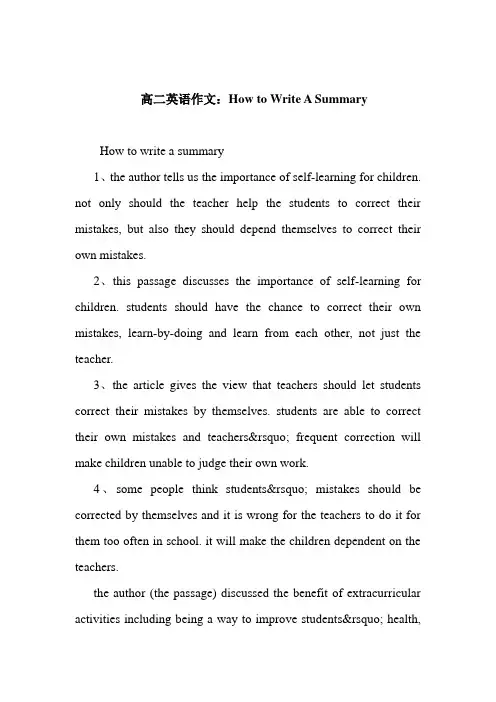
高二英语作文:How to Write A SummaryHow to write a summary1、the author tells us the importance of self-learning for children. not only should the teacher help the students to correct their mistakes, but also they should depend themselves to correct their own mistakes.2、this passage discusses the importance of self-learning for children. students should have the chance to correct their own mistakes, learn-by-doing and learn from each other, not just the teacher.3、the article gives the view that teachers should let students correct their mistakes by themselves. students are able to correct their own mistakes and teachers’ frequent correction will make children unable to judge their own work.4、some people think students’ mistakes should be corrected by themselves and it is wrong for the teachers to do it for them too often in school. it will make the children dependent on the teachers.the author (the passage) discussed the benefit of extracurricular activities including being a way to improve students’ health,widen their social circle and introduce them to new ideas and people.reviews the most important points of the text. it should be brief (short). furthermore, the summary should be written as much as possible in your own words. it contains only the main ideas and what the author talks about the topic but not include much explanation or examples.。
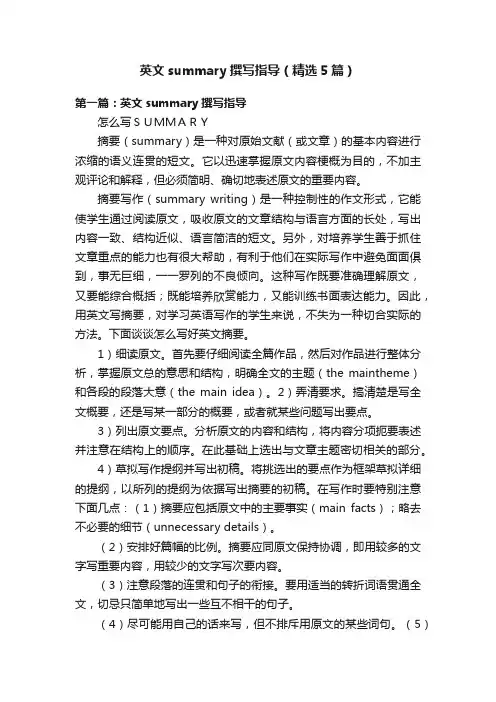
英文summary撰写指导(精选5篇)第一篇:英文summary撰写指导怎么写SUMMARY摘要(summary)是一种对原始文献(或文章)的基本内容进行浓缩的语义连贯的短文。
它以迅速掌握原文内容梗概为目的,不加主观评论和解释,但必须简明、确切地表述原文的重要内容。
摘要写作(summary writing)是一种控制性的作文形式,它能使学生通过阅读原文,吸收原文的文章结构与语言方面的长处,写出内容一致、结构近似、语言简洁的短文。
另外,对培养学生善于抓住文章重点的能力也有很大帮助,有利于他们在实际写作中避免面面俱到,事无巨细,一一罗列的不良倾向。
这种写作既要准确理解原文,又要能综合概括;既能培养欣赏能力,又能训练书面表达能力。
因此,用英文写摘要,对学习英语写作的学生来说,不失为一种切合实际的方法。
下面谈谈怎么写好英文摘要。
1)细读原文。
首先要仔细阅读全篇作品,然后对作品进行整体分析,掌握原文总的意思和结构,明确全文的主题(the maintheme)和各段的段落大意(the main idea)。
2)弄清要求。
搞清楚是写全文概要,还是写某一部分的概要,或者就某些问题写出要点。
3)列出原文要点。
分析原文的内容和结构,将内容分项扼要表述并注意在结构上的顺序。
在此基础上选出与文章主题密切相关的部分。
4)草拟写作提纲并写出初稿。
将挑选出的要点作为框架草拟详细的提纲,以所列的提纲为依据写出摘要的初稿。
在写作时要特别注意下面几点:(1)摘要应包括原文中的主要事实(main facts);略去不必要的细节(unnecessary details)。
(2)安排好篇幅的比例。
摘要应同原文保持协调,即用较多的文字写重要内容,用较少的文字写次要内容。
(3)注意段落的连贯和句子的衔接。
要用适当的转折词语贯通全文,切忌只简单地写出一些互不相干的句子。
(4)尽可能用自己的话来写,但不排斥用原文的某些词句。
(5)计算词数,看是否符合规定的词数要求。
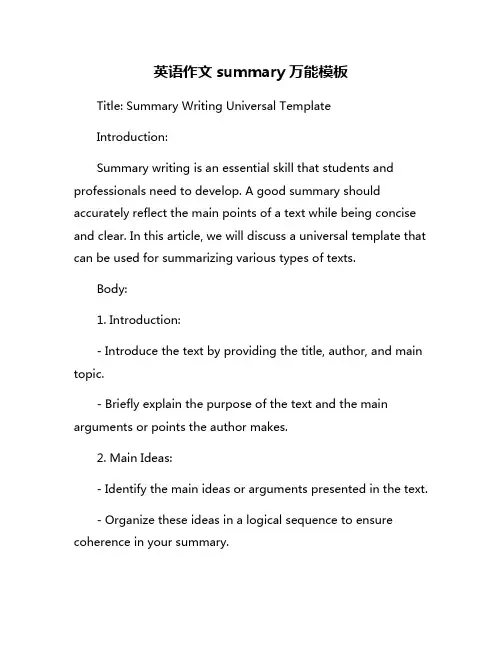
英语作文summary万能模板Title: Summary Writing Universal TemplateIntroduction:Summary writing is an essential skill that students and professionals need to develop. A good summary should accurately reflect the main points of a text while being concise and clear. In this article, we will discuss a universal template that can be used for summarizing various types of texts.Body:1. Introduction:- Introduce the text by providing the title, author, and main topic.- Briefly explain the purpose of the text and the main arguments or points the author makes.2. Main Ideas:- Identify the main ideas or arguments presented in the text.- Organize these ideas in a logical sequence to ensure coherence in your summary.- Keep in mind that you should focus on the most important points and avoid including minor details.3. Supporting Details:- Include relevant supporting details that help explain or clarify the main ideas.- Use specific examples, quotes, or statistics from the text to strengthen your summary.4. Conclusion:- Summarize the main points of the text in a concise manner.- Restate the main argument or thesis of the text in your own words.- Provide a brief closing statement that reflects on the significance of the text or its implications.5. Editing and Proofreading:- Review your summary to ensure it accurately represents the original text.- Check for grammatical errors, typos, and inconsistencies in your writing.- Make any necessary revisions to improve the clarity and effectiveness of your summary.Conclusion:Summary writing is a valuable skill that requires practice and attention to detail. By using the universal template outlined in this article, you can effectively summarize any text and communicate its main ideas to your readers. Remember to focus on the most important points, include supporting details, and edit your summary carefully to ensure its accuracy and clarity. With dedication and effort, you can master the art of summary writing and enhance your communication skills in English.。
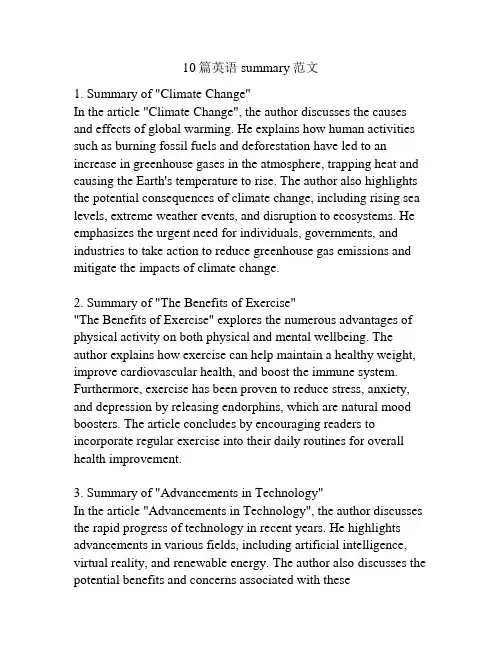
10篇英语summary范文1. Summary of "Climate Change"In the article "Climate Change", the author discusses the causes and effects of global warming. He explains how human activities such as burning fossil fuels and deforestation have led to an increase in greenhouse gases in the atmosphere, trapping heat and causing the Earth's temperature to rise. The author also highlights the potential consequences of climate change, including rising sea levels, extreme weather events, and disruption to ecosystems. He emphasizes the urgent need for individuals, governments, and industries to take action to reduce greenhouse gas emissions and mitigate the impacts of climate change.2. Summary of "The Benefits of Exercise""The Benefits of Exercise" explores the numerous advantages of physical activity on both physical and mental wellbeing. The author explains how exercise can help maintain a healthy weight, improve cardiovascular health, and boost the immune system. Furthermore, exercise has been proven to reduce stress, anxiety, and depression by releasing endorphins, which are natural mood boosters. The article concludes by encouraging readers to incorporate regular exercise into their daily routines for overall health improvement.3. Summary of "Advancements in Technology"In the article "Advancements in Technology", the author discusses the rapid progress of technology in recent years. He highlights advancements in various fields, including artificial intelligence, virtual reality, and renewable energy. The author also discusses the potential benefits and concerns associated with theseadvancements. While technology has brought efficiency and convenience, it also raises ethical questions, such as privacy and job displacement. Overall, the article emphasizes the importance of embracing and adapting to technological advancements while addressing the associated challenges.4. Summary of "The Importance of Education""The Importance of Education" emphasizes the value of education in personal and societal development. The author explains how education provides individuals with knowledge, skills, and critical thinking abilities necessary for success in various aspects of life. Additionally, education plays a crucial role in promoting equality, social cohesion, and economic growth. The article emphasizes the need for accessible and quality education for all individuals, regardless of their socio-economic backgrounds.5. Summary of "The Impact of Social Media""The Impact of Social Media" discusses the influence of platforms such as Facebook, Twitter, and Instagram on society. The author explores both the positive and negative aspects of social media. On one hand, it has created new opportunities for communication, networking, and social activism. On the other hand, it has also contributed to issues such as cyberbullying, addiction, and the spread of misinformation. The article concludes by encouraging individuals to use social media responsibly and critically evaluate the information they encounter.6. Summary of "The Importance of a Balanced Diet""The Importance of a Balanced Diet" highlights the significance of consuming a variety of foods for overall health and wellbeing. Theauthor explains how a balanced diet consisting of fruits, vegetables, whole grains, lean proteins, and healthy fats provides essential nutrients that support bodily functions and prevent diseases. The article also emphasizes the need to limit the intake of processed foods, sugary drinks, and excessive amounts of salt and saturated fats. By maintaining a balanced diet, individuals can reduce the risk of chronic diseases and improve their overall quality of life.7. Summary of "The Impact of Tourism on Local Communities" "The Impact of Tourism on Local Communities" examines the positive and negative effects of tourism on the economy, environment, and culture of a destination. The author discusses how tourism can generate revenue, create job opportunities, and promote cultural exchange. However, it can also contribute to environmental degradation, exploitation of local resources, and the loss of cultural heritage. The article emphasizes the importance of sustainable tourism practices that minimize the negative impacts and benefit both tourists and local communities in the long run.8. Summary of "The Benefits of Volunteering""The Benefits of Volunteering" explores the positive effects of volunteering on both individuals and communities. The author explains how volunteering can enhance personal development, improve mental health, and promote social connections. Additionally, volunteering plays a crucial role in addressing societal issues and creating positive change. The article highlights the various ways individuals can get involved in volunteering and encourages readers to contribute their time and skills to make a difference.9. Summary of "The Dangers of Plastic Pollution""The Dangers of Plastic Pollution" sheds light on the environmental hazards posed by plastic waste. The author explains how plastic pollution affects marine life, ecosystems, and human health. He discusses the excessive consumption of single-use plastics, inadequate waste management systems, and the lack of recycling infrastructure as major contributors to the problem. The article encourages readers to reduce their plastic consumption, recycle properly, and support initiatives aimed at addressing plastic pollution.10. Summary of "The Importance of Mental Health""The Importance of Mental Health" emphasizes the significance of mental well-being in overall health and happiness. The author discusses the prevalence of mental health disorders and the stigma surrounding them. He highlights the importance of seeking help, practicing self-care, and creating a supportive environment for individuals with mental health challenges. The article encourages readers to prioritize their mental health, raise awareness, and advocate for better access to mental health services.。

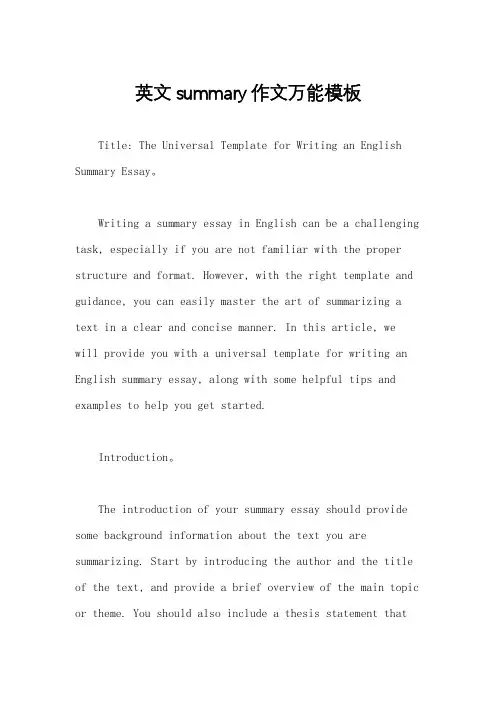
英文summary作文万能模板Title: The Universal Template for Writing an English Summary Essay。
Writing a summary essay in English can be a challenging task, especially if you are not familiar with the proper structure and format. However, with the right template and guidance, you can easily master the art of summarizing a text in a clear and concise manner. In this article, wewill provide you with a universal template for writing an English summary essay, along with some helpful tips and examples to help you get started.Introduction。
The introduction of your summary essay should provide some background information about the text you are summarizing. Start by introducing the author and the title of the text, and provide a brief overview of the main topic or theme. You should also include a thesis statement thatclearly states the main point or argument of the text.Body Paragraphs。
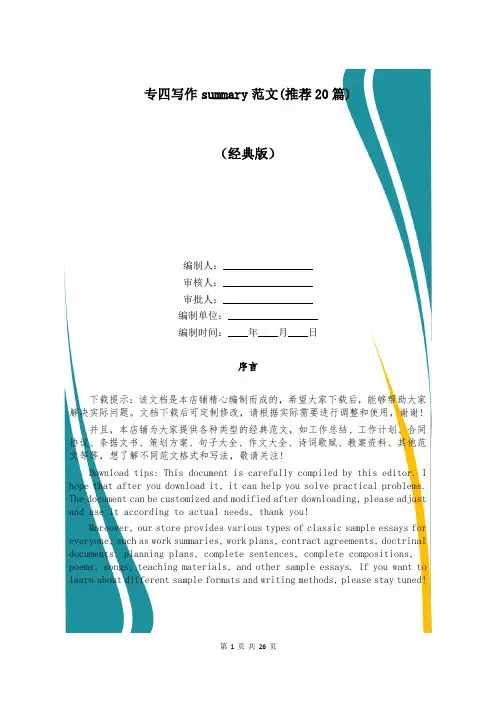
专四写作summary范文(推荐20篇)(经典版)编制人:__________________审核人:__________________审批人:__________________编制单位:__________________编制时间:____年____月____日序言下载提示:该文档是本店铺精心编制而成的,希望大家下载后,能够帮助大家解决实际问题。
文档下载后可定制修改,请根据实际需要进行调整和使用,谢谢!并且,本店铺为大家提供各种类型的经典范文,如工作总结、工作计划、合同协议、条据文书、策划方案、句子大全、作文大全、诗词歌赋、教案资料、其他范文等等,想了解不同范文格式和写法,敬请关注!Download tips: This document is carefully compiled by this editor. I hope that after you download it, it can help you solve practical problems. The document can be customized and modified after downloading, please adjust and use it according to actual needs, thank you!Moreover, our store provides various types of classic sample essays for everyone, such as work summaries, work plans, contract agreements, doctrinal documents, planning plans, complete sentences, complete compositions, poems, songs, teaching materials, and other sample essays. If you want to learn about different sample formats and writing methods, please stay tuned!专四写作summary范文(推荐20篇)专四写作summary范文第1篇ArticleChildren Must be Taught to Tell Right from WrongWilliam KilpatrickMany of today’s young people have a difficult time seeing any moral dimension (道德层面)to their actions.There are a number of reasons why that’s true, but none more prominent than a failed system of education that eschews (回避)teaching children the traditional moral values that bind Americans together as a society and a culture.That failed approach,called “decision-making,” was introduced in schools 25 years ago.It tells children to decide for themselves what is right and what is wrong.It replaced “character education.(品格教育)” Character education didn’t ask children to reinvent the moral wheel (浪费时间重新发明早已存在的道德标准); instead,it encouraged them to practice habits of courage, justice and self-control.In the 1940s,when a character education approach prevailed,teachers worried about students chewing gum; today they worry about robbery and rape.Decision-making curriculums pose thorny (棘手的)ethicaldilemmas to students, leaving them with the impression that all morality is problematic and that all questions of right and wrong are in dispute.Youngsters are forced to question values and virtues they’ve never acquired in the first place or upon which they have only a tenuous (薄弱的)hold.The assumption behind this method is that students will arrive at good moral conclusions if only they are given the chance.But the actual result is moral confusion.For eXample, a recent national study of 1,700 siXth- to ninth-graders revealed that a majority of boys considered rape to be acceptable under certain conditions.Astoundingly,many of the girls agreed.This kind of moral illiteracy is further encouraged by values-education (价值观教育)programs that are little more than courses in self-esteem (自尊).These programs are based on the questionable assumption that a child who feels good about himself or herself won’t want to do anything wrong.But it is just as reasonable to make an opposite assumption: namely, that a child who has uncritical self-regard will conclude that he or she can’t do anything bad.Such naive self-acceptance results in large part from the non-directive (无指导性的), non-judgmental (无是非观的),as-long-as-you-feel-comfortable-with-your-choices mentality (思想)that has pervaded (渗透)public education for the last two and one-half decades.Many of today’s drug education, seX education and values-education courses are based on the same 1960s philosophy that helped fuel the eXplosion in teen drug use and seXual activity in the first place.Meanwhile, while educators are still fiddling with (胡乱摆弄)outdated “feel-good”approaches,New York,Washington, and Los Angeles are burning.Youngsters are leaving school believing that matters of right and wrong are always merely subjective.If you pass a stranger on the street and decide to murder him because you need money—if it feels right —you go with that feeling.Clearly, murder is not taught in our schools, but such a conclusion—just about any conclusion —can be reached and justified using the decision-making method.It is time to consign (寄出)the fads (风尚)of “decision-making” and “non-judgmentalism” to the ash heap of failed policies, and return to a proved method.Character education provides a much more realistic approach to moral formation.It is built on an understanding that we learn morality not by debating it but by practicing it.SampleSummary of “Children Must be Taught to Tell Right from Wrong”In his essay “Children Must be Taught to Tell Right from Wrong,”William Kilpatrick argues fervently that the “decision-making” approach to the moral education of American youth, which replaced “character education” 25 years ago,has prevented juveniles from behaving and thinking in accordance with the traditional moral principles that are fundamental to American society.According to Kilpatrick, decision-making methods instill in students a wrong belief that all norms of morality are subjective constructs with only relative truth in them and therefore can be interpreted fleXibly and even questioned.This belief deprives them of the chance to secure solid moral standards and induces misconceptions about what should be clearly right or wrong.In parallel with this inadequacy of the “decision-making”approach are the uneXpected outcomes of those values-education programs focusing on students’ self-esteem that subscribe to the “non-judgmental” mindset dominating “decision-making”curriculums.Their mistaken assumption that feeling good warrants morality eXcuses students from criticizing anddisciplining their own behaviors.Basing his conclusion on his analysis of the fundamental flaws of the decision-making approach, Kilpatrick finally proposes an immediate shift back to character education which he believes teaches morality more effectively by emphasizing practice instead of discussion.专四专八精选好课暖心助学新东方好老师手把手带学专四写作summary范文第2篇Write on ANSWER SHEET ONE a composition of about 200 words on the following topic:Nowadays instead of hunting for jobs to work for the others,more and more college students would rather choose to start their independent business after graduation.Some people think it is a good way for them to realize their self-value.What is your idea?MY VIEW ON CLOOEGE STUDENTS’STARTING INDEPENDENT BUSINESSYou are to write in three parts.In the first part, state specifically what your view is.In the second part, support your view with several reasons.In the last part, bring what you have written to a natural conclusion or a summary.专四写作summary范文第3篇The Best Way to Stay HealthNowadays,the desire for good health is universal.Wherever you are and whatever you do,staying healthy is always important.With the improvement of our living standards, people are attaching more and more importance to their health.However,which do you think is the best way to keep healthy? Different people come up with different views: eating green food, doing outdoor eXercises or going to hospital for medical treatment frequently.As far as I am concerned, the best way to keep healthy is to develop a good quality of psychology.According to some surveys, nowadays, most patients are not physically sick but mentally ill.The burden on their shoulders is much heavier than others, so they cant step out of the shadow of depression and sadness.They need to release their spirit to the nature.Besides, if you have developed a good quality of psychology,you’ll become more sociable and thus more willing to play your part in the society.Enrolling for some keep-fit clubs or joining some travel agency, which by themselves are various versions of physical eXercise, will benefit you a lot.As a poem says, youth is not a period of time; it’s a stateof mind.Everybody wants to keep young at heart because youth is a symbol for endless energy and passion for living.Keep a good quality of mind, or keep a sense of humor, to be precise,even if you are 80, and you’ll never be old.专四写作summary范文第4篇一、提纲式作文1.对立观点式A.有人认为X 是好事,赞成X,为什么?B.有人认为X 是坏事,反对X,为什么?C.我的看法。
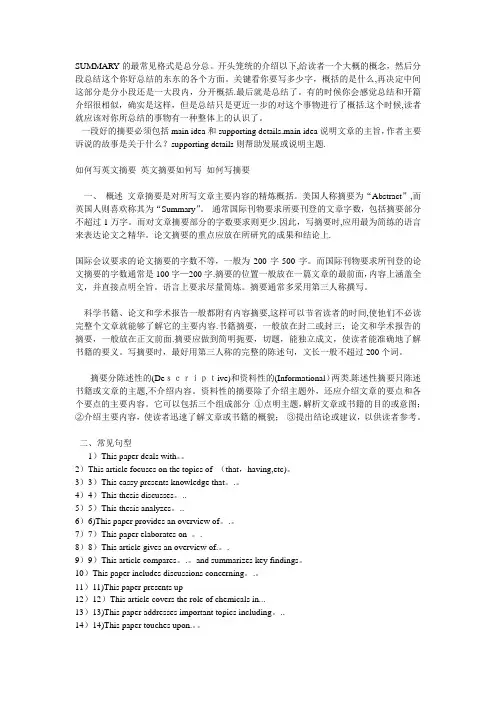
SUMMARY的最常见格式是总分总。
开头笼统的介绍以下,给读者一个大概的概念,然后分段总结这个你好总结的东东的各个方面。
关键看你要写多少字,概括的是什么,再决定中间这部分是分小段还是一大段内,分开概括.最后就是总结了。
有的时候你会感觉总结和开篇介绍很相似,确实是这样,但是总结只是更近一步的对这个事物进行了概括.这个时候,读者就应该对你所总结的事物有一种整体上的认识了。
一段好的摘要必须包括main idea和supporting details.main idea说明文章的主旨,作者主要诉说的故事是关于什么?supporting details则帮助发展或说明主题.如何写英文摘要英文摘要如何写如何写摘要一、概述文章摘要是对所写文章主要内容的精炼概括。
美国人称摘要为“Abstract”,而英国人则喜欢称其为“Summary”。
通常国际刊物要求所要刊登的文章字数,包括摘要部分不超过1万字。
而对文章摘要部分的字数要求则更少.因此,写摘要时,应用最为简练的语言来表达论文之精华。
论文摘要的重点应放在所研究的成果和结论上.国际会议要求的论文摘要的字数不等,一般为200字-500字。
而国际刊物要求所刊登的论文摘要的字数通常是100字—200字.摘要的位置一般放在一篇文章的最前面,内容上涵盖全文,并直接点明全旨。
语言上要求尽量简炼。
摘要通常多采用第三人称撰写。
科学书籍、论文和学术报告一般都附有内容摘要,这样可以节省读者的时间,使他们不必读完整个文章就能够了解它的主要内容.书籍摘要,一般放在封二或封三;论文和学术报告的摘要,一般放在正文前面.摘要应做到简明扼要,切题,能独立成文,使读者能准确地了解书籍的要义。
写摘要时,最好用第三人称的完整的陈述句,文长一般不超过200个词。
摘要分陈述性的(Descriptive)和资料性的(Informational)两类.陈述性摘要只陈述书籍或文章的主题,不介绍内容。
资料性的摘要除了介绍主题外,还应介绍文章的要点和各个要点的主要内容。
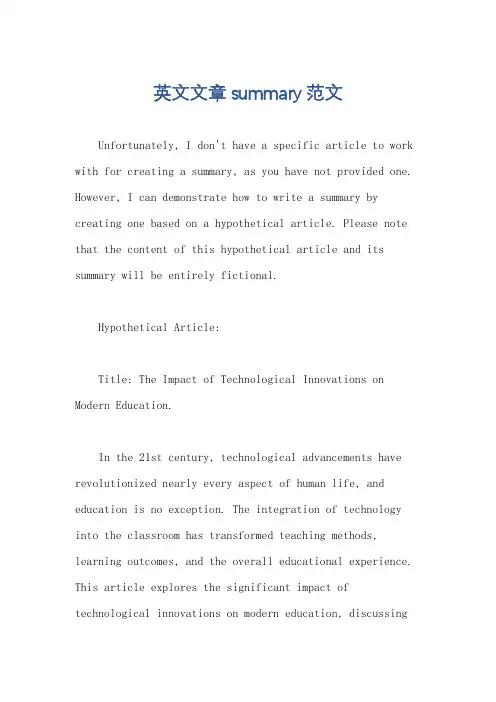
英文文章summary范文Unfortunately, I don't have a specific article to work with for creating a summary, as you have not provided one. However, I can demonstrate how to write a summary by creating one based on a hypothetical article. Please note that the content of this hypothetical article and its summary will be entirely fictional.Hypothetical Article:Title: The Impact of Technological Innovations on Modern Education.In the 21st century, technological advancements have revolutionized nearly every aspect of human life, and education is no exception. The integration of technology into the classroom has transformed teaching methods, learning outcomes, and the overall educational experience. This article explores the significant impact of technological innovations on modern education, discussingboth the benefits and challenges they present.1. Enhanced Access to Resources and Information.The internet has greatly expanded access to educational resources, enabling students and teachers to access a vast library of information at their fingertips. Online databases, virtual libraries, and interactive learning platforms provide instant access to up-to-date materials, enhancing the quality and diversity of educational content.2. Personalized Learning.Technological advancements have facilitated personalized learning, allowing educators to tailor their teaching methods to the individual needs and learningstyles of students. Adaptive learning platforms, for instance, can adjust the difficulty level and pace of content based on the student's performance, providing a more customized learning experience.3. Collaborative Learning Environments.Technology has also enabled more collaborative learning environments, where students can work together in real-time, regardless of their physical location. Collaborative tools such as online forums, wikis, and video conferencing software foster communication and teamwork, promoting amore engaged and interactive learning process.4. Challenges and Limitations.Despite the numerous benefits of technological innovations in education, there are also challenges and limitations to consider. One significant concern is the digital divide, where students from economically disadvantaged backgrounds may lack access to the necessary technology or internet connectivity. Additionally, the overuse of technology can lead to distractions in the classroom, affecting student engagement and learning outcomes.5. The Role of Educators.In the age of technological advancements, it is crucial for educators to stay up-to-date with the latest trends and tools. They must be able to integrate technologyeffectively into their teaching methods while maintaining a focus on student engagement and learning outcomes. By doing so, they can harness the power of technology to enhance the educational experience and prepare students for the future.Summary:The integration of technological innovations into modern education has brought about significant changes in teaching methods, learning outcomes, and the overall educational experience. These advancements have enhanced access to resources and information, facilitated personalized learning, and fostered more collaborative learning environments. However, challenges such as the digital divide and the potential for distractions remain.It is crucial for educators to stay up-to-date with technology and use it effectively to enhance student engagement and learning outcomes. By harnessing the powerof technology, we can prepare students for the future and ensure that education remains relevant and effective.。
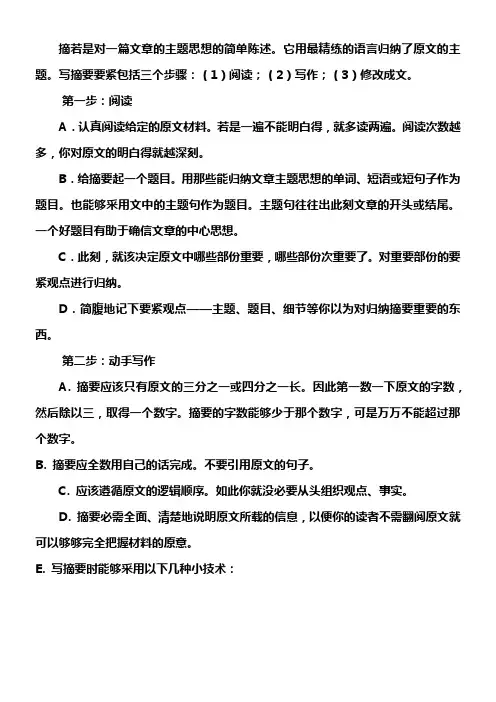
摘若是对一篇文章的主题思想的简单陈述。
它用最精练的语言归纳了原文的主题。
写摘要要紧包括三个步骤:(1)阅读;(2)写作;(3)修改成文。
第一步:阅读A.认真阅读给定的原文材料。
若是一遍不能明白得,就多读两遍。
阅读次数越多,你对原文的明白得就越深刻。
B.给摘要起一个题目。
用那些能归纳文章主题思想的单词、短语或短句子作为题目。
也能够采用文中的主题句作为题目。
主题句往往出此刻文章的开头或结尾。
一个好题目有助于确信文章的中心思想。
C.此刻,就该决定原文中哪些部份重要,哪些部份次重要了。
对重要部份的要紧观点进行归纳。
D.简腹地记下要紧观点——主题、题目、细节等你以为对归纳摘要重要的东西。
第二步:动手写作A. 摘要应该只有原文的三分之一或四分之一长。
因此第一数一下原文的字数,然后除以三,取得一个数字。
摘要的字数能够少于那个数字,可是万万不能超过那个数字。
B. 摘要应全数用自己的话完成。
不要引用原文的句子。
C. 应该遵循原文的逻辑顺序。
如此你就没必要从头组织观点、事实。
D. 摘要必需全面、清楚地说明原文所载的信息,以便你的读者不需翻阅原文就可以够够完全把握材料的原意。
E. 写摘要时能够采用以下几种小技术:1) 删除细节。
只保留要紧观点。
2) 选择一至两个例子。
原文中可能包括5个或更多的例子,你只需从中挑选一至二个例子。
3) 把长段的描述变成短小、简单的句子。
若是材料中描述某人或某事用了十个句子,那么你只要把它们变成一两句即可。
4) 幸免重复。
在原文中,为了强调某个主题,可能会重复论证说明。
可是这在摘要中是不能利用的。
应该删除那些突出强调的重述句。
5) 紧缩长的句子。
如以下两例:“His courage in battle might without exaggeration be called lion-like.”能够归纳为:”He was very brave in battle.”“He was hard up for money and was being pressed by his creditor.”能够归纳为:“He was in financial difficulties.”6) 你还能够利用词组代替整句或从句。
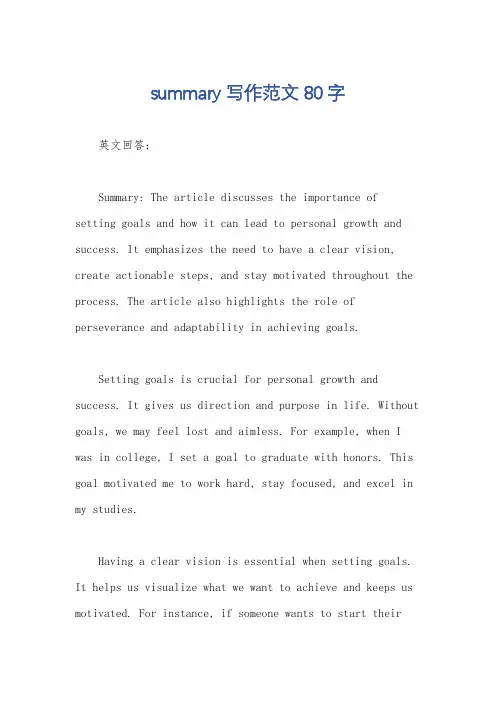
summary写作范文80字英文回答:Summary: The article discusses the importance ofsetting goals and how it can lead to personal growth and success. It emphasizes the need to have a clear vision, create actionable steps, and stay motivated throughout the process. The article also highlights the role of perseverance and adaptability in achieving goals.Setting goals is crucial for personal growth and success. It gives us direction and purpose in life. Without goals, we may feel lost and aimless. For example, when I was in college, I set a goal to graduate with honors. This goal motivated me to work hard, stay focused, and excel in my studies.Having a clear vision is essential when setting goals. It helps us visualize what we want to achieve and keeps us motivated. For instance, if someone wants to start theirown business, they should have a clear vision of what the business will look like and how it will operate. Thisvision will guide them in making decisions and takingaction towards their goal.Creating actionable steps is another important aspectof goal setting. It involves breaking down the goal into smaller, manageable tasks. This allows us to track our progress and stay motivated. For instance, if someone wants to run a marathon, they can start by setting smaller goals such as running a certain distance each day orparticipating in shorter races. These small steps will eventually lead them to their ultimate goal.Perseverance is key when working towards our goals. We may face obstacles and setbacks along the way, but it's important to stay determined and never give up. For example, when I started learning a new language, I faceddifficulties and felt frustrated at times. However, I persevered and kept practicing, which eventually led to fluency.Adaptability is also crucial in goal setting. Sometimes, our initial plans may not work out as expected, and we need to be flexible and open to change. For instance, if someone's goal is to get a promotion at work, but they face unexpected challenges, they may need to adapt their strategies or explore alternative opportunities. Being adaptable allows us to overcome obstacles and continue moving forward.In conclusion, setting goals is essential for personal growth and success. It provides us with direction, motivation, and a sense of purpose. By having a clear vision, creating actionable steps, and staying motivated,we can achieve our goals. Perseverance and adaptability are also important traits that help us overcome challenges and achieve success.中文回答:Summary: 本文讨论了设定目标的重要性,以及它如何促进个人成长和成功。
高中英语summary范文高中英语写作中,对于summary这样的主题大家会写吗?下面是店铺给大家带来高中英语summary总结性范文,供大家参阅!高中英语summary范文篇What is a summary?Summary is a short passage giving the main points of an original article. What should we pay attention to when we write a summary? 主题文体记叙文 write a summary 人称议论文时态说明文记叙文的概括:1、时态2、人称 5要素3、____________读写任务(记叙文):时态、人称、5要素 Who WhatHowWhen wherePractice 1: Before my last birthday,my parents promised to celebrate my birt hday withsad me. I don’t have many unhappy memories but one story took place on my last birthday. Before the birthday, I worked out a plan with my parents. We planned to have dinner together in McDonald’s, my favourite restaurant. Then we would go to the Xinghai Concert Hall for a concert given by a group of famous young singers. And the most exciting thing, of course, was the birthday presents. They promised to give me a new MP3 player. However, something unexpected happened on that day. I went home as early as I could. I waited and waited but my parents didn’t come back. But they finally forgot and I felt angry. I felt angry at first and then upset. How could they treat me this way? They always forgot me just because they were busy with their work. Yes, they were always busy. They broke theirpromise and got home late. After that, my grandmother had a talk with me to help me understand my parents’ situation and that made me feel much better.After talking with my grandma, I felt better.A possible version:According to the passage,the author felt disappointed because his parents forgot to celebrate his last birthday with him. But he came to understand them after talking to his grandmother. Tips: 时态、人称、要素Practice 2: A little boy is telling his Grandma how “everything” is going wrong. School, family problem, severe health problems, etc. Meanwhile, Grandma is baking a cake. She asks her grandson if he would like a cake, which, of course, he does. “Here, have some cooking oil.” “Terrible!” says the boy. “How about a couple raw eggs?” “Terrible! Grandma!” “Would you like some flour then? Or maybe baking soda?” “Grandma, those are all awful!” To which Grandma replies, “Yes, all those things seem bad by themselves, but when they are put together in the right way, they make a wonderfully delicious cake!Grandma used the cake material to show him that…“The trials(考验) of life serve a meaningful purpose in making us stronger. Do not lose heart if life is not easy for you right now, but encourage yourself and know you will be much stronger mentally and physically because of the trials of life.”According to the passage, a little boy complained about problems in life. His grandmother used the cake material to teach him that the trials of life make people stronger.One beautiful spring day a red rose came out in a forest. The red rose looked at a cactus (仙人掌) and said, “ What an uglyplant full of thorns (刺)!” The pine tree said, “ Red rose, what kind of talk is this? Who can say what beauty is? You have thorns too.” The p roud red rose looked angrily at the pine and said, “You don’t know what beauty is. You can’t compare me to a cactus.” Spring passed, and the weather became very warm. Life became difficult as no rain fell. The red rose was dying. One day the red rose saw b irds suck water from the cactus. “Doesn’t it hurt when they bite into the cactus?” asked the red rose. “Yes, but the cactus does not like to see any birds suffer,” replied the pine. “The birds can bring water to you if you ask the cactus for help.” But the red rose felt too ashamed of its past words to ask.(记叙文)寓言文体: ____________ 时态:________________ 人称:____________________ Who What HowWhen where5要素a beautiful roselaughed at the cactus for its appearance felt ashamed when she saw the cactus giving water to help the birdsOnce a beautiful proud rose laughed at the cactus for its appearance. However, when the weather became dry, the rose felt ashamed of itself as she saw the cactus providing birds with water.Score: 4-5二.梗概写作的注意事项1.不要照抄原文。
英文作文如何写summary下载温馨提示:该文档是我店铺精心编制而成,希望大家下载以后,能够帮助大家解决实际的问题。
文档下载后可定制随意修改,请根据实际需要进行相应的调整和使用,谢谢!并且,本店铺为大家提供各种各样类型的实用资料,如教育随笔、日记赏析、句子摘抄、古诗大全、经典美文、话题作文、工作总结、词语解析、文案摘录、其他资料等等,如想了解不同资料格式和写法,敬请关注!Download tips: This document is carefully compiled by theeditor. I hope that after you download them,they can help yousolve practical problems. The document can be customized andmodified after downloading,please adjust and use it according toactual needs, thank you!In addition, our shop provides you with various types ofpractical materials,such as educational essays, diaryappreciation,sentence excerpts,ancient poems,classic articles,topic composition,work summary,word parsing,copyexcerpts,other materials and so on,want to know different data formats andwriting methods,please pay attention!First of all, you need to read the original text carefully and understand its main ideas. Then, pick out the key points and important details. Don't include everything, just the most essential stuff. Use your own words to summarize, not the exact same words from the text. Keep it short and to the point. For example, say what the maintopic is and the main arguments or events. And that's basically it. Another thing is to make sure your summary makes sense and is clear. It should give a good overview of the original text without being too complicated. You canalso add a few examples if it helps. Just don't make it too long or it won't be a summary anymore. And that's how you write a summary. Sometimes it can be a bit tricky, but with practice, you'll get better at it. Oh, and don't forget to check for grammar and spelling mistakes. That's important too. So, that's my advice on writing a summary. Good luck! 。
英文简短的summary范文1.英文写作中的summary应该怎么写首先Summary的写作应该分为以下6步:①分段阅读首先,我们需要对整篇文章浏览一次,根据文中的标题、副标题等分段阅读。
②重读主动阅读文章,并把主题句、关键句以及对写作summary 有用的信息标记出来。
③概括在明确了每个分段的中心思想之后,用一句话概括出来。
注意:句中只需要关键点,不需要进行细节性的描述。
④主旨主旨句是一篇摘要的关键点,读者可从中获知整篇文章所要表达的内容。
因此,一定要写好主旨句。
⑤写summary 在写summary的时候一定要注意:在summary中需要写原作者和作品的名称,且要用现在时去写作,尽量避免使用原文内容。
除此之外,摘要的写作目的在于准确表达作者的观点,所以一定不可以添加自己的观点在里边。
⑥检查并修改在summary完成之后需要检查我们是否准确的将作者的观点表达出来了,如果没有问题的话,也还是需要从个事、语法以及标点等方面进行一次检查。
下边BayDue给大家分享一篇summary写作范文:Why do some animals die out?In the past two hundred years people have caused many kinds of animals to die out--to become extinct.People keep building houses and factories in fields and woods.As they spread over the land,they destroy animals’homes.If the animals can’t find a place tolive,they die out.Sixteen kinds of Hawaiian birds have become extinct for this reason.Other animals,such as the Florida Key deer,may soon die out because they are losing their homes.Hunters have caused some animals to become extinct,too.In the last century,hunters killed all the passenger pigeons in North America and most of the buffalos.Today they are fast killing off hawks and wolves.Pollution is killing many animals today,too.As rivers become polluted,fish are poisoned.Many die.Birds that eat the poisoned fish can’t lay strong,healthy eggs.New birds aren’t born.So far,no animals have become extinct because of pollution.But some,such as the bald eagle and the brown pelican,have become rare and may die out.Scientists think that some animals become extinct because of changes in climate.The places where they live become hotter or cooler,drier or wetter.The food that they eat cannot grow there any more.If the animals can’t learn to eat something else,they die.Dinosaurs may have died out for this reason.Summary:In the past two hundred years,many kinds of animals have died out.There are several reasons for it.First,people keep building houses and factories in fields and woods,which destroys animals’homes.Then,hunters’killing has also caused some animals to become extinct.Besides,some a nimals aren’t able to bear strong offspring and nor do they have enough food to eat because of pollution and climatic changes.。
10篇英语summary范文The ability to effectively summarize information is a crucial skill in both academic and professional settings. A well-crafted summary allows readers to quickly grasp the key points and main ideas of a longer text, saving time and enhancing comprehension. In this essay, we will explore 10 examples of English summaries that demonstrate best practices and techniques.Example 1: Book SummaryThe Kite Runner by Khaled Hosseini is a powerful novel that explores themes of guilt, redemption, and the complex relationships between fathers and sons. The story follows the life of Amir, a young boy from Kabul, Afghanistan, and his lifelong friend Hassan. As children, Amir witnesses a traumatic event involving Hassan, which sets in motion a chain of events that haunts him for decades. The novel follows Amir's journey as he attempts to atone for his past mistakes and find redemption. Through vivid characters and a gripping narrative, The Kite Runner provides a poignant look at the impact of war, class divisions, and the human capacity for both cruelty and compassion.Example 2: Research Paper SummaryThe study by Smith et al. (2020) investigated the effectiveness of a new educational intervention designed to improve critical thinking skills among undergraduate students. The researchers implemented the intervention in two sections of an introductory psychology course and compared the results to a control group. The findings indicate that students who participated in the intervention demonstrated significantly higher scores on a standardized critical thinking assessment compared to the control group. The authors suggest that the intervention, which focused on teaching specific critical thinking strategies, could be a valuable tool for enhancing cognitive skills in higher education. The study provides important insights for educators and researchers interested in developing effective methods for cultivating critical thinking abilities in college students.Example 3: Article SummaryThe article "The Importance of Sleep for Cognitive Function" by Jones (2019) examines the relationship between sleep and cognitive performance. The author reviews extensive research demonstrating that adequate sleep is essential for various cognitive processes, including attention, memory, decision-making, and problem-solving. The article discusses how sleep deprivation can impair these cognitive functions, leading to decreased productivity, increased errors, and reduced overall cognitive abilities. Jones emphasizes theneed for individuals, especially those in demanding cognitive professions, to prioritize getting sufficient high-quality sleep. The article concludes by providing practical tips and strategies for improving sleep habits to optimize cognitive performance.Example 4: Movie SummaryThe film Inception, directed by Christopher Nolan, is a mind-bending science fiction thriller that explores the concept of dream manipulation. The story follows Dom Cobb, a skilled "extractor" who is tasked with performing "inception" – implanting an idea in a target's subconscious through the use of shared dreaming technology. Cobb assembles a team to carry out a seemingly impossible job: to plant an idea in the mind of a powerful businessman, Robert Fischer, in order to break up his father's business empire. As the team delves deeper into Fischer's subconscious, they encounter increasingly complex and dangerous dream layers, blurring the line between reality and fantasy. The film's intricate plot, stunning visuals, and thought-provoking themes make Inception a captivating and intellectually stimulating cinematic experience.Example 5: Scientific Study SummaryThe study published in the Journal of Experimental Psychology: General by Wilson et al. (2014) examined the effects of mindfulness meditation on cognitive flexibility. The researchers recruited a groupof participants and randomly assigned them to either a mindfulness meditation training program or a control group. The results showed that individuals who completed the mindfulness meditation training demonstrated significantly greater cognitive flexibility, as measured by their performance on a set-shifting task, compared to the control group. The authors suggest that the practice of mindfulness, which involves cultivating present-moment awareness and acceptance, can enhance the brain's ability to adapt to changing circumstances and think in more flexible, creative ways. These findings have important implications for understanding the cognitive benefits of mindfulness-based interventions and their potential applications in educational and clinical settings.Example 6: Book Review SummaryIn her book "Educated," Tara Westover recounts her extraordinary journey from growing up in a deeply isolated, survivalist Mormon family in the mountains of Idaho to ultimately earning a Ph.D. from Cambridge University. Westover's memoir is a powerful and poignant exploration of the value of education, the complexities of family relationships, and the resilience of the human spirit. Despite facing numerous challenges, including physical and emotional abuse, Westover's thirst for knowledge and her determination to forge her own path in life are deeply inspiring. The book provides a thought-provoking examination of the tension between tradition and personal growth, and the transformative power of education inshaping one's identity and future.Example 7: TED Talk SummaryIn her TED Talk "The Power of Vulnerability," researcher Brené Brown discusses the importance of embracing vulnerability as a pathway to authentic connection and personal growth. Brown's engaging presentation draws on her extensive research on shame, empathy, and the human need for belonging. She argues that by cultivating the courage to be imperfect and openly sharing our struggles, we can foster deeper, more meaningful relationships and unlock our full potential. Brown's insights challenge the common perception of vulnerability as a weakness, and instead present it as a vital component of living a fulfilling and meaningful life. The talk resonates with audiences by providing a relatable and empowering message about the transformative power of vulnerability.Example 8: Podcast Episode SummaryIn the episode "The Science of Habit Formation" from the podcast "Hidden Brain," host Shankar Vedantam explores the psychological and neurological mechanisms underlying the development of habits. The episode delves into the research on how habits are formed, maintained, and changed, drawing on the work of experts in the field of behavioral psychology. Vedantam discusses the role of the brain's reward system in reinforcing habitual behaviors, as well as strategies for breaking unwanted habits and cultivating new, more beneficialones. The episode provides listeners with a deeper understanding of the science behind habit formation and offers practical insights for individuals seeking to improve their own habits and behaviors.Example 9: Conference Presentation SummaryAt the 2021 International Conference on Artificial Intelligence, Dr. Emily Chen delivered a presentation titled "Ethical Considerations in AI Development." In her talk, Chen addressed the growing concerns around the potential misuse and unintended consequences of artificial intelligence technologies. She highlighted key ethical principles, such as fairness, transparency, and accountability, that should be at the forefront of AI development and deployment. Chen discussed case studies of AI systems that have exhibited biases and discriminatory behaviors, and she emphasized the importance of incorporating ethical frameworks into the design and implementation of AI-powered applications. The presentation provided valuable insights for researchers, policymakers, and industry leaders working to ensure that the advancement of AI technology aligns with societal values and promotes the greater good.Example 10: News Article SummaryThe article "The Impacts of Climate Change on Global Food Security" published in The New York Times examines the growing threat that climate change poses to the world's food supply. The article outlineshow rising temperatures, changing precipitation patterns, and an increase in extreme weather events are disrupting agricultural production, leading to crop failures, livestock losses, and food shortages in many regions. The article discusses the disproportionate impact on developing countries, where food insecurity is already a pressing issue, and the potential for conflict and mass migration as a result of these climate-related disruptions. The article also highlights the efforts of scientists, policymakers, and agricultural organizations to develop more resilient farming practices and adapt to the changing climate. The piece serves as a sobering reminder of the urgent need to address the global challenge of climate change and its far-reaching consequences for food security and human well-being.。
Original:My neighbor's children love playing hide-and-seek as all children do, but no one imagine that a game they played last week would be reported in the local newspaper.One afternoon, they were playing in the vacant lot down the corner. Young Paul, who is only five years old, found the perfect place to hide. His sister, Natalie, had shut her eyes and was counting to ten when Paul noticed the storage mail box at the corner and saw that the metal door was standing open. The mailman had just taken out several sacks of mail and had carried them to his truck which was standing at the curb a few feet away. Paul climbed into the storage box and pulled the door closed so hard that it locked. Soon realizing what he had done, he became frightened and started crying. Meanwhile, Natalie was looking for him everywhere but could not find him. It was lucky that she happened to pause at the corner for a minute and heard her brother's cries. She immediately ran to tell the mailman who hurried back from his truck to unlock the metal door. Paul was now free, but he had had such a bad scare that he could not stop crying. The mailman, however, soon found a way of making him laugh again. He told him that the next time he wanted to hide in a mail box, he should remember to put a stamp on himself!Summary:The children were playing hide-and-seek in a vacant lot one afternoon.Finding that the storage mailbox had been left open, Paul hid and locked himself in it accidentally. His sister, Natalie, heard his cries and realized where he was hiding, so she immediately told the mailman to unlock the metal door. After letting him out, the mailman made him stop crying by telling him to put a stamp on himself the next he wanted to hide in a mailbox.Original:Why do some animals die out?In the past two hundred years people have caused many kinds of animals to die out--to become extinct. People keep building houses and factories in fields and woods. As they spread over the land, they destroy animals' homes. If the animals can't find a place to live, they die out. Sixteen kinds of Hawaiian birds have become extinct for this reason. Other animals, such as the Florida Key deer, may soon die out because they are losing their homes.Hunters have caused some animals to become extinct, too. In the last century, hunters killed all the passenger pigeons in North America and most of the buffalos.Today they are fast killing off hawks and wolves.Pollution is killing many animals today, too. As rivers become polluted, fish are poisoned. Many die. Birds that eat the poisoned fish can't lay strong, healthy eggs. New birds aren’t born. So far, no animals have become extinct because of pollution. But some, such as the bald eagle and the brown pelican, havebecome rare and may die out.Scientists think that some animals become extinct because of changes in climate. The places where they live become hotter or cooler, drier or wetter. The food that they eat cannot grow there any more. If the animals can't learn to eat something else, they die. Dinosaurs may have died out for this reason.Summary:In the past two hundred years, many kinds of animals have died out. There are several reasons for it. First, people keep building houses and factories in fields and woods, which destroys animals' homes. Then, hunters' killing has also caused some animals to become extinct. Besides, some animals aren't able to bear strong offspring and nor do they have enough food to eat because of pollution and climatic changes.Love languagesDo you know love what “love languages”are? Love languages are different ways that people show their love to others. We all want to have relationships where we can show our love to others and have them communicate love to us in return. In order to be successful in communicating love, we need to understand what the different love languages are. There are five important love languages that people need to know about to communicate effectively with others.The first love language is Quality Time which refers to spending timetogether with the person you are trying to show your love to. This love language will cause people to feel loved when they are taken out on special dates, when their friend changes their schedules to be with them, or when they turn the television off to talk with them. It means giving all of your attention to another person.Another love language is Words of Attention as a way to show your love. Telling your boyfriend or girlfriend how you appreciate them, encouraging them, and through words praising them will show people that you love them. Telling someone “I believe in you” can really make someone feel loved. With this love language you can express yourself through both spoken and written words.Gifts is another type of love language. Gifts are not just material objects, they are expressions of your love. The most important aspect is not the cost, but the fact that you were thinking of them and spent the time to go and buy them a gift. Big or little, your gift will be a symbol of your love for the other person.Fourth is the love language called Acts of Service which means you express your love by helping someone else. You could help them with a difficult assignment ot help them fix their bicycle when it is broken. The most important part of this love languages is taking the time to do things for them that require thought, energy and time. Don’t wait to only do what they ask you to, but volunteer to show your kindness.The last love language is Physical Touch. A simple touch on the arm, hug or backrub will convey your love to them. Sit beside them when you have the chance and hole their hand when you are walking down the street. With this love language, just being near them and showing your care through touch will make them feel very loved.Just knowing about these love languages is not enough as they way in which people feel loves by others is different. It is important to know which love language is strongest for the person you are trying to love. Sometimes if you serve them, they will feel more loved than if you give them a gift. Or perhaps holding their hand will not be as meaningful to them as if you had spent two hours together. I recommend that you find out what the love language is of the person you are trying to love. Don’t forget that there is more than just one love language. As you learn how to give and receive love, you will find that your relationships with others will be richer and more satisfying.Olympic GamesOf all the games held throughout Greece, those staged at Olympia in honor of Zeus are the most famous. The Games, like all Greek games, were an intrinsic part of a religious festival. Held every four years between August 6 and September 19, they occupied such an important place in Greek life that time was measured by the interval between them – an Olympiad. Although the first Olympic champion listed in the records was one Coroebusof Elis, a cook, who won the sprint race in 776 BC, it is generally accepted that the Games were probably at least 500 years old at that time. According to one legend, they were founded by Heracles, son of Alcmene.The Games were held at Olympia in the city-state of Elis, on a track about 32 meters (35 yards) wide.The racing length was one stade, a distance of about 192 meters (210 yards) which was one length of the track. At the meeting in 776 BC, there was apparently only one event, the stade, but other events were added over the ensuing decades. In 724 BC a two-length race, diaulos, roughly similar to the 400-meter race, was included and four years later, the dolichos, a long-distance race possibly to be compared to the modern 1500- or even 5000-meter event, was added . wresting and the pentathlon were introduced in 708BC. The latter was an all-around competition consisting of five events – the long jump, javelin throw, discus throw, foot race, and wresting.Boxing was introduced in 688 BC, and in 680 a chariot race. In 648, the pancratium, a kind of all-strength, or no-hold-barred, wresting was included. Kicking and hitting were allowed; only biting and gouging (thrusting a finger ot thumb into an opponent’s eye) were forbidden. Between 632 and 616 BC, events for boys were introduced. And from time to time, further events were added including contests for fully armed soldiers, for heralds, and for trumpeters. The program must have been as varied as that of the modern Olympics, although the athletics (track and field) eventswere limited: there was no high jumping in any form and no individual field event, except in the pentathlon.Until the 77th Olympiad (472 BC) all of the contests took place on one day; later they were spread, with, perhaps, some fluctuations, over four days, with a fifth devoted to the closing ceremony presentation of prizes and a banquet for the champions. Sources generally agree that women were not allowed as competitors or, except for the priestess of Demeter, as spectators. In most events, the athletes participated in the nude.The Olympic Games were originally restricted to free-born Greeks. The competitors, including those who came from the Greek colonies, were amateur in the sense that the only prize was a wreath or garland. The athletes underwent a most rigorous of supervised training, however, and eventually, the contestants were true professionals. Not only were there substantial prizes for winning, but the Olympic champion also received adulation and unlimited benefits from his city. Athletes became fulltime specialists –a trend that in the modern games has caused a long and bitter controversy over amateurism.Summary example:In this article, the author explains the history of some of the earliest record Olympic Games held in Greece. It is generally accepted that these Games started around 1276 BC although the first champion was recorded in 776 BC. In the first Games there was only one event, however as time wenton, different events were added. Longer distance running races were first added and then other events like wresting and the pentathlon. They even added events specially for boys and armed soldiers. Originally the Games were played on one day but this changed to five days. Another aspect of the Games was that women were not allowed as competitors or spectators. The competitors were also restricted to Greeks who were not professionals. However, a trend started where athletes became full-time specialists which ahs caused a lot of controversy.The original:A third kind of thinking is stimulated when anyone questions our beliefs and opinions. We sometimes find ourselves changing our minds without any resistance or heavy emotion, but if we are told that we are wrong we resent the imputation and harden our hearts. We are incredibly heedless in the formation of our beliefs, but find ourselves filled with an illicit passion for them when anyone proposes to rob us of their companionship. It is obviously not the idea themselves that are dear to us, but our self-esteem, which is threatened. We may surrender, but rarely confess ourselves vanquished. In the intellectual world at least, peace is without victory.Few of us take the pains to study the origin of our cherished convictions; indeed, we have a natural repugnance to so doing. We like to continue to believe what we have been accustomed to accept as true, and the resentment aroused when doubt is cast upon any of our assumptions leads us seek every manner of excuse for clinging to them. The result is that most of our so-called reasoning consists in finding arguments for going on believing as we already do.Summary:A third kind of thinking occurs when we are told that our beliefs andopinions are wrong. We may have been heedless in their formation, butour self-esteem will not permit us to change. We may have to give up, but we are not convinced. We do not study the origin of our beliefs; we believe as we have been accustomed to believe, and we seek arguments forcontinuing to believe as we already do.。
Children Must be Taught to Tell Right from WrongWilliam KilpatrickMany of today’s young people have a difficult time seeing any moral dimension (道德层面) to their actions. There are a number of reasons why that’s true, but none more prominent than a failed system of education that eschews (回避) teaching children the traditional moral values that bind Americans together as a society and a culture. That failed approach, called “decision-making,” was introduced in schools 25 years ago. It tells children to decide for themselves what is right and what is wrong. It replaced “character education. (品格教育)” Character education didn’t ask children to reinvent the moral wheel(浪费时间重新发明早已存在的道德标准); instead, it encouraged them to practice habits of courage, justice and self-control.In the 1940s, when a character education approach prevailed, teachers worried about students chewing gum; today they worry about robbery and rape.Decision-making curriculums pose thorny (棘手的) ethical dilemmas to students, leaving them with the impression that all morality is problematic and that all questions of right and wrong are in dispute. Youngsters are forced to question values and virtues they’ve never acquired in the first place or upon which they have only a tenuous (薄弱的) hold. The assumption behind this method is that students will arrive at good moral conclusions if only they are given the chance. But the actual result is moral confusion.For example, a recent national study of 1,700 sixth- to ninth-graders revealed that a majority of boys considered rape to be acceptable under certain conditions. Astoundingly, many of the girls agreed.This kind of moral illiteracy is further encouraged by values-education (价值观教育) programs that are little more than courses in self-esteem (自尊). These programs are based on the questionable assumption that a child who feels good about himself or herself won’t want to do anything wrong. But it is just as reasonable to make an opposite assumption: namely, that a child who has uncritical self-regard will conclude that he or she can’t do anything bad.Such naive self-acceptance results in large part from the non-directive (无指导性的), non-judgmental (无是非观的), as-long-as-you-feel-comfortable-with-your-choices mentality (思想) that has pervaded (渗透) public education for the last two and one-half decades. Many of today’s drug education, sex education and values-education courses are based on the same 1960s philosophy that helped fuel the explosion in teen drug use and sexual activity in the first place.Meanwhile, while educators are still fiddling with (胡乱摆弄) outdated “feel-good” approaches, New York, Washington, and Los Angeles are burning. Youngsters are leaving school believing that matters of right and wrong are always merely subjective. If you pass a stranger on the street and decide to murder him because you need money—if it feels right—you go with that feeling. Clearly, murder is not taught in our schools, but such a conclusion—just about any conclusion—can be reached and justified using the decision-making method.It is time to consign (寄出) the fads (风尚) of “decision-making” and “non-judgmentalism” to the ash heap of failed policies, and return to a proved method. Character education provides a much more realistic approach to moral formation. It is built on an understanding that we learn morality not by debating it but by practicing it.Summary of “Children Must be Taught to Tell Right from Wrong”In his essay “Children Must be Taught to Tell Right from Wrong,” William Kilpatrick argues fervently that the “decision-making”approach to the moral education of American youth, which replaced “character education” 25 years ago, has prevented juveniles from behaving and thinking in accordance with the traditional moral principles that are fundamental to American society.According to Kilpatrick, decision-making methods instill in students a wrong belief that all norms of morality are subjective constructs with only relative truth in them and therefore can be interpreted flexibly and even questioned. This belief deprives them of the chance to secure solid moral standards and induces misconceptions about what should be clearly right or wrong.In parallel with this inadequacy of the “de cision-making” approach are the unexpected outcomes of those values-education programs focusing on students’ self-esteem that subscribe to the “non-judgmental” mindset dominating “decision-making” curriculums. Their mistaken assumption that feeling good warrants morality excuses students from criticizing and disciplining their own behaviors.Basing his conclusion on his analysis of the fundamental flaws of the decision-making approach, Kilpatrick finally proposes an immediate shift back to character education which he believes teaches morality more effectively by emphasizing practice instead of discussion.。